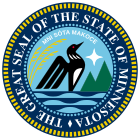 |
|---|
| Constitution |
Minnesota is known for a politically active citizenry, with populism being a longstanding force among the state's political parties. Minnesota has consistently high voter turnout; in the 2008 U.S. presidential election, 77.8% of eligible Minnesotans voted – the highest percentage of any U.S. state or territory – versus the national average of 61.7%.[1] This was due in part to its same day voter registration laws; previously unregistered voters can register on election day, at their polls, with evidence of residency.[2]
The major political parties are the Minnesota Democratic–Farmer–Labor Party (DFL) and the Republican Party of Minnesota, along with the Grassroots-Legalize Cannabis and Legal Marijuana Now parties since 2018. The DFL was founded in 1944 when the Minnesota Democratic Party and Minnesota Farmer–Labor Party merged. The party is affiliated with the national Democratic Party. Supporters of the DFL are often referred to as "DFLers" in Minnesota by both members and non-members of the party as an alternative to "Democrats". The state Republican Party is affiliated with the national Republican Party.
- ^ Michael P. McDonald. "2008 Unofficial Voter Turnout". United States Elections Project, George Mason University. Archived from the original on November 13, 2008. Retrieved November 20, 2008.
- ^ Huefner, Steven F., Daniel P Tokaji, and Edward B. Foley (2007), From Registration to Recounts: The Election Ecosystems of Five Midwestern States (Archived March 25, 2009, at the Wayback Machine), The Ohio State University Moritz College of Law, p. 137 (Archived March 25, 2009, at the Wayback Machine). ISBN 978-0-9801400-0-2.
© MMXXIII Rich X Search. We shall prevail. All rights reserved. Rich X Search
